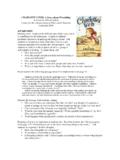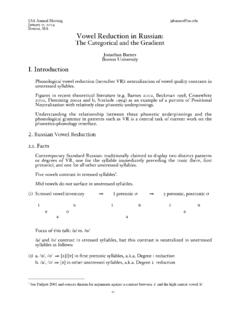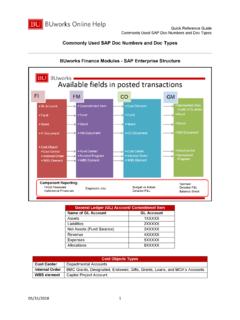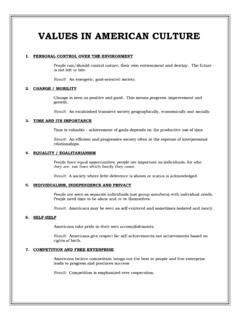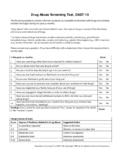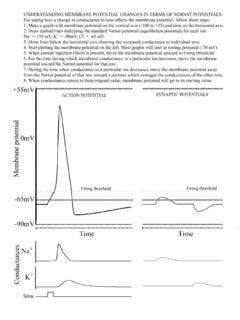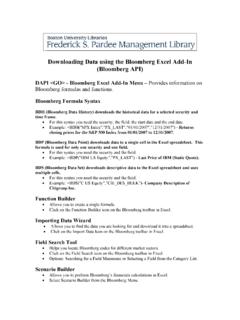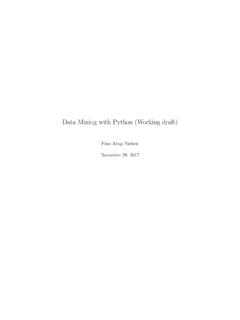Transcription of Python for Data Analysis - Boston University
1 Python for Data AnalysisResearch Computing ServicesKatia Oleinik Content2 Overview of Python Libraries for Data ScientistsReading Data; Selecting and Filtering the Data; Data manipulation, sorting, grouping, rearranging Plotting the dataDescriptive statisticsInferential statisticsPython Libraries for Data ScienceMany popular Python toolboxes/libraries: NumPy SciPy Pandas SciKit-LearnVisualization libraries matplotlib Seabornand many more ..3 All these libraries are installed on the SCCP ython Libraries for Data ScienceNumPy: introduces objects for multidimensional arrays and matrices, as well as functions that allow to easily perform advanced mathematical and statistical operations on those objects provides vectorization of mathematical operations on arrays and matrices which significantly improves the performance many other Python libraries are built on NumPy4 Link: Libraries for Data ScienceSciPy: collection of algorithms for linear algebra, differential equations, numerical integration, optimization, statistics and more part of SciPyStack built on NumPy5 Link: Libraries for Data SciencePandas.
2 Adds data structures and tools designed to work with table-like data (similar to Series and Data Frames in R) provides tools for data manipulation: reshaping, merging, sorting, slicing, aggregation etc. allows handling missing data6 Link: : Libraries for Data ScienceSciKit- learn : provides machine learning algorithms: classification, regression, clustering, model validation etc. built on NumPy, SciPyand matplotlib7matplotlib: Python 2D plotting library which produces publication quality figures in a variety of hardcopy formats aset of functionalities similar to those of MATLAB line plots, scatter plots, barcharts, histograms, pie charts etc. relatively low-level; some effort needed to create advanced visualizationLink: Libraries for Data Science8 Seaborn: based on matplotlib provides high level interface for drawing attractive statistical graphics Similar (in style) to the popular ggplot2 library in RLink: Libraries for Data Science9 Login to the Shared Computing Cluster Use your SCC login information if you have SCC account If you are using tutorial accounts see info on the blackboardNote: Your password will not be displayed while you enter Python Version on the SCC# view available Python versions on the SCC[scc1 ~] module avail Python # load Python 3 version[scc1 ~] module load tutorial notebook# On the Shared Computing Cluster[scc1 ~]cp/project/scv/examples/ Python /data_ # On a local computer save the link.
3 Jupyternootebook# On the Shared Computing Cluster[scc1 ~]jupyternotebook13In [ ]:Loading Python Libraries14#Import Python Librariesimportnumpyasnpimportscipyasspi mportpandas aspdimportmatplotlibasmplimportseabornas snsPress Shift+Enterto execute the jupytercellIn [ ]:Reading data using pandas15#Read csv filedf= (" ")There is a number of pandas commands to read other data (' ',sheet_name='Sheet1', index_col=None, na_values=['NA']) (' ') (' ') (' ','df')Note: The above command has many optional arguments to fine-tune the data import [3]:Exploring data frames16#List first 5 ()Out[3]:Hands-on exercises17 Try to read the first 10, 20, 50 records; Can you guess how to view the last few records; Hint:Data Frame data typesPandas TypeNative Python TypeDescriptionobjectstringThe most general dtype.
4 Will be assigned to your column if column has mixed types (numbers and strings).int64intNumeric characters. 64 refers to the memory allocated to hold this characters with decimals. If a column contains numbers and NaNs(see below), pandas will default to float64, in case your missing value has a , timedelta[ns]N/A (but see thedatetimemodule in Python s standard library)Values meant to hold time data. Look into these for time series [4]:Data Frame data types19#Check a particular column typedf['salary'].dtypeOut[4]: dtype('int64')In [5]:#Check types for all the [4]:rank discipline phdservice sex salary dtype: objectobjectobjectint64int64objectint64 Data Frames attributes20 Python objects have attributesand the types of the columnscolumnslist the column namesaxeslist the row labelsand column namesndimnumber of dimensionssizenumber of elements shapereturn a tuplerepresenting the dimensionality valuesnumpyrepresentation of the dataHands-on exercises21 Find how many records this data frame has; How many elements are there?
5 What are the column names? What types of columns we have in this data frame?Data Frames ()descriptionhead( [n] ), tail( [n] )first/lastn rowsdescribe()generate descriptive statistics (for numeric columns only)max(), min()return max/minvalues for all numeric columnsmean(), median()return mean/medianvalues for all numeric columnsstd()standard deviationsample([n])returns a random sample of thedata framedropna()drop all the records with missing valuesUnlike attributes, Python methods have attributes and methods can be listed with a dir() function: dir(df)Hands-on exercises23 Give the summary for the numeric columns in the dataset Calculate standard deviation for all numeric columns; What are the mean values of the first 50 records in the dataset?Hint:use head() method to subset the first 50 records and then calculate the meanSelecting a column in a Data FrameMethod 1: Subset the data frame using column name:df['sex']Method 2: Use the column name as an :there is an attribute rankfor pandas data frames, so to select a column with a name "rank" we should use method exercises25 Calculate the basic statistics for the salarycolumn; Find how many values in the salarycolumn (use countmethod); Calculate the average salary.
6 Data Frames groupbymethod26 Using "group by" method we can: Split the data into groups based on some criteria Calculate statistics (or apply a function) to each group Similar to dplyr() function in RIn [ ]:#Group data using rankdf_rank= (['rank'])In [ ]:#Calculate mean value for each numeric column per each ()Data Frames groupbymethod27 Once groupbyobject is create we can calculate various statistics for each group:In [ ]:#Calculate mean salary for each professor ('rank')[['salary']].mean()Note:If single brackets are used to specify the column ( salary), then the output is Pandas Series object. When double brackets are used the output is a Data FrameData Frames groupbymethod28groupbyperformance notes:-no grouping/splitting occurs until it's needed. Creating the groupbyobject only verifies that you have passed a valid mapping-by default the group keys are sorted during the groupbyoperation.
7 You may want to pass sort=False for potential speedup:In [ ]:#Calculate mean salary for each professor (['rank'],sort=False)[['salary']].mean() Data Frame: filtering29To subset the data we can apply Boolean indexing. This indexing is commonly known as a filter. For example if we want to subset the rows in which the salary value is greater than $120K: In [ ]:#Calculate mean salary for each professor rank:df_sub= df[df['salary'] > 120000 ]In [ ]:#Select only those rows that contain female professors:df_f= df[df['sex'] == 'Female' ]Any Boolean operator can be used to subset the data:> greater; >= greater or equal;< less; <= less or equal;== equal; != not equal; Data Frames: Slicing30 There are a number of ways to subset the Data Frame: one or more columns one or more rows a subset of rows and columnsRows and columns can be selected by their position or label Data Frames: Slicing31 When selecting one column, it is possible to use single set of brackets, but the resulting object will be a Series (not a DataFrame): In [ ]:#Select column salary:df['salary']When we need to select more than one column and/or make the output to be a DataFrame, we should use double brackets:In [ ]:#Select column salary:df[['rank','salary']]Data Frames: Selecting rows32If we need to select a range of rows, we can specify the range using ":" In [ ]:#Select rows by their position:df[10.]
8 20]Notice that the first row has a position 0, and the last value in the range is omitted:So for 0:10 range the first 10 rows are returned with the positions starting with 0 and ending with 9 Data Frames: method loc33If we need to select a range of rows, using their labels we can use method loc:In [ ]:#Select rows by their [10:20,['rank','sex','salary']]Out[ ]:Data Frames: method iloc34If we need to select a range of rows and/or columns, using their positions we can use method iloc:In [ ]:#Select rows by their [10:20,[0, 3, 4, 5]]Out[ ]:Data Frames: method iloc(summary) [0] # First row of a data [i] #(i+1)throw [-1] # Last row [:, 0] # First [:, -1] # Last column [0:7] #First 7 rows [:, 0:2] #First 2 [1:3, 0:2] #Second through third rows and first 2 [[0,5], [1,3]] #1stand 6throws and 2ndand 4thcolumnsData Frames: Sorting36We can sort the data by a value in the column.
9 By default the sorting will occur in ascending order and a new data frame is return. In [ ]:# Create a new data frame from the original sorted by the column Salarydf_sorted= ( by='service') ()Out[ ]:Data Frames: Sorting37We can sort the data using 2 or more columns:In [ ]:df_sorted= ( by=['service','salary'], ascending = [True,False]) (10)Out[ ]:Missing Values38 Missing values are marked as NaNIn [ ]:# Read a dataset with missing valuesflights = (" ")In [ ]:# Select the rows that have at least one missing valueflights[ ().any(axis=1)].head()Out[ ]:Missing Values39 There are a number of methods to deal with missing values in the data ()descriptiondropna()Drop missing observationsdropna(how='all')Drop observations where all cells is NAdropna(axis=1, how='all')Drop column if all the values aremissingdropna(thresh = 5)Drop rows that contain less than 5 non-missing valuesfillna(0)Replace missing values with zerosisnull()returns True if the value is missingnotnull()Returns True for non-missing valuesMissing Values40 When summing the data, missing values will be treated as zero If all values are missing, the sum will be equal to NaN cumsum() and cumprod() methods ignore missing values but preserve them in the resulting arrays Missing values in GroupBymethod are excluded (just like in R)
10 Many descriptive statistics methods have skipnaoption to control if missing data should be excluded . This value is set to True by default (unlike R)Aggregation Functions in Pandas41 Aggregation -computing a summary statistic about each group, compute group sums or means compute group sizes/countsCommon aggregation functions:min, maxcount, sum, prodmean, median, mode, madstd, varAggregation Functions in Pandas42agg() method are useful when multiple statistics are computed per column:In [ ]:flights[['dep_delay','arr_delay']].agg (['min','mean','max'])Out[ ]:Basic Descriptive ()descriptiondescribeBasic statistics (count, mean, std, min, quantiles, max)min, maxMinimumand maximum valuesmean, median, modeArithmetic average, median and modevar, stdVariance and standard deviationsemStandard error of meanskewSample skewnesskurtkurtosisGraphics to explore the data44To show graphs within Python notebook include inline directive:In [ ]:%matplotlibinlineSeabornpackage is built on matplotlibbut provides high level interface for drawing attractive statistical graphics, similar to ggplot2 library in R.
